

CHAPTER I
GEORGE MCCREARY
GEORGE1 MCCREARY
George McCreary was born in 1752 in County Armagh, Province of Ulster, in what is currently Northern Ireland according to his testimony for a pension.1 His parents weren’t named but according to naming patterns, his father may have been Thomas since George’s first born son was named Thomas. George died on 26 February 1842 in Knox County, now Morrow County, Ohio.2 He is buried in Chester Baptist Church Cemetery, Chester Township, Morrow County, Ohio. The grave marker was placed on his grave about 1935 by Eva Gardner, his great-great granddaughter.
In correspondence from Eva Gardner in 1937 to W. O. McCreary Sr., she said “George’s grandson, George Washington McCreary told her that there is a tradition that George the immigrant came as a cabin boy on a British vessel to Baltimore with General Howe and then deserted to the Colonial troops and that he married in Chester County, Pennsylvania, an Irish girl, although George (the grandson) could not recall her name. He also said his grandfather went on a man’s bond and “broke up” and lost his property and worked as deputy clerk in a glass factory on Graves Creek northeast of Wheeling. Then he removed to Licking County, Ohio and was hurt in a storm near Burlington in that county.”3 Chester County didn’t record marriages until 1885 so no proof is available.
Scotch Irish
In a family history compiled by Marjorie MacCreary in 1961, she wrote about the MacQuarries, McCrearys, MacCrearys, McCreerys, etc. and their ancestry. She felt most of these people who came to America from Northern Ireland, belonged to those exiles known as the “Scotch-Irish.’. The term is frequently used in Pennsylvania but not understood, even by those who claim this as their nationality. Many assume that if their ancestors came from Northern Ireland they were Irish. However, the Scotch Irish came from Scotland nearly a hundred years before their migration to America. The reason they left Scotland was John Calvin of the Presbyterians.4
Armagh, Ireland
In researching records in County Armagh, Ireland, I believe I may have found George’s family. In the list of inhabitants of the Town of Armagh, (in the County of Armagh) for use of his Grace the Lord Primate, in the year 1770, there is a Tho. McCreary and wife listed. His trade was a barber, he had one child and his religion was Presbyterian. In the town there were two individuals with similar names, a Geo McCreery & wife, and a Jno. McCrerry, however, Thomas was the only McCreary. I’ve searched through Presbyterian records for the Armagh Presbyterian church but the marriage and baptism records that survive are from 1707-1728 and 1798-1809 which are too early or too late to find this family. I also did not find any McCrearys on the County Armagh Freeholders list although most of the dates were too early.
County Armagh is in Northern Ireland and the county is about sixteen miles wide and about 283 square miles. In 1804 the County contained eight baronies (Armagh, Turenny, O’Neil and E, O’Neil and W, Upper Fews, Lower Fews, Upper Orior, and Lower Orior.) Ecclesiastically it contained twenty-one parishes. A considerable amount of the land was church and college property and the average size of the farms was 5 acres. Armagh was descripted as the most populous county in Ireland at that time although much of its surface is covered with mountains, yet the greater part of the wildest country is very thickly inhabited. 1705 houses contained 6988 souls.4 A more recent description from about 1980 describes County Armagh as 512 square miles and a population of about 128,200. The northern part of the County is lowland and hills and mountainous in South Armagh. Agriculture is dominant, then textiles (linen, wool, and cotton.) In 1881 the population of the City of Armagh was 10,070. No McCrearys were listed in the city directory of 1888.
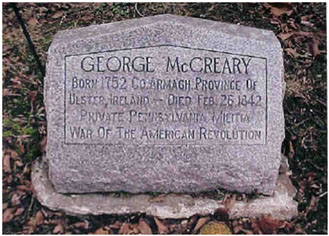
George McCreary tombstone 1752-1842
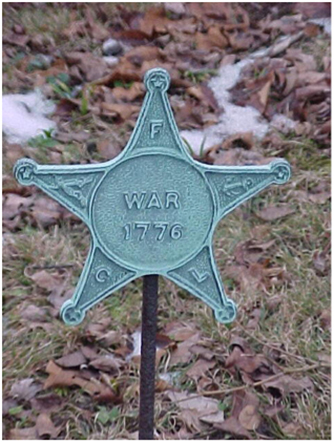
Revolutionary War 1776 marker

McCreary row of graves, Chester Baptist Cemetery
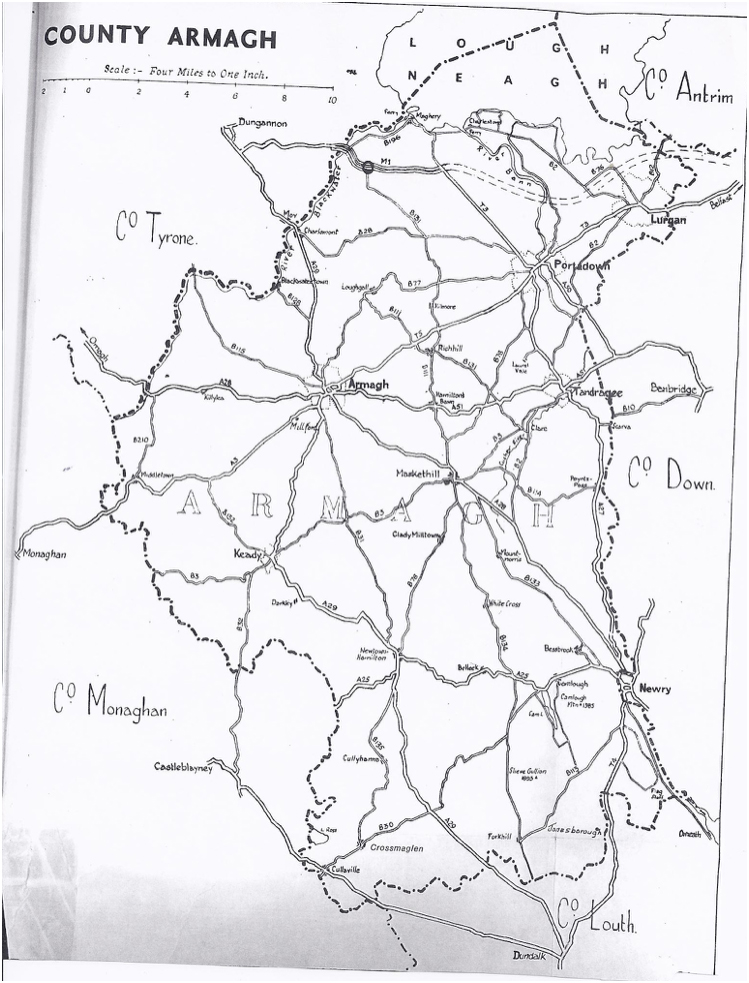
Map County Armagh, now Northern Ireland
Emigration from County Armagh is dominated by the mass migration during the mid-nineteenth century which occurred as the result of a significant slump in the linen industry and the devastation caused by the Great Famine. Emigration had already taken place on a large scale during the previous century. These emigrants were for the most part Protestant, and in particular Presbyterian. During the early part of the eighteenth century, many of these emigrants could not afford the passage money and had to work their way out as indentured servants. However, as the century wore on there was a marked rise in the affluence and social status of the average emigrant. The main cause of eighteenth century emigration was not primarily economic, although in times of depression such as the late 1720s and 1770s there were substantial increases in the number of emigrants. The main cause of emigration at this time was the attraction of the American colonies for those who were eager to improve their prospects – younger sons in particular. America was also seen as a land where freedom of religion was guaranteed. Throughout the eighteenth century, Pennsylvania drew the majority of the Ulster emigrants.8 George McCreary seemed to fit this description.

The Memorial Hall, Abbey Street in Armagh, which was used as a Church by the Presbyterian Congregation of First Armagh from 1725-187?. Might be where George McCreary’s family worshiped.
George married Mary McQuown about 1781, perhaps in Menallen Township, York County, Pennsylvania (now Adams County) but marriage records weren’t maintained until 1885. That part of York County became Adams County in 1800. Mary probably died in Licking County, Ohio. Mary McQuown was born in Ireland probably between 1753 and 1760. One researcher says Mary McQuown McCreary died about July 1831 but I’ve found no proof.
The following is an article that appeared in the Genealogy Society of Ireland Journal and it tells about his wife, Mary McQuown’s family.
“Laurance McQuown, his wife Jean, and their thirteen children sailed from Londonderry, Ireland to America in 1761 or 1762. The first known record of Laurance in America appeared on the Tax Rolls of Menallen Township, York County, Pennsylvania with the surname spelled McCoon. Subsequent census and tax records had the surname spelled in different ways, although McQuown was the most prevalent and his will, dated 13 July, 1789, was signed Laurance McQuown. Laurance died sometime between the signing of his will and 15 August, 1789 when the document was probated. In addition to his wife Jean, the following children were listed as beneficiaries in the will, and I must assume that the order of the listing represents the order of birth:
Thomas McQuown, who married Margaret Sillik Galloway
John McQuown
William McQuown
Catherine McQuown, who married Isaac Leany or Loany
David Samuel McQuown, who married Margaret, or Mary Harris
Elizabeth McQuown, who married Able Hasty, or Hesty
Mary McQuown, who married George McCreary
Jean McQuown, who married David Pantan
Rebecah McQuown, who married Benjamin Stewart
Laurance McQuown
Margret McQuown
Elenor McQuown
I have little doubt that the family came to the Colonies from Ireland, as the Histories of Westmoreland, Armstrong, and Indiana Counties of Pennsylvania indicate that Laurance’s son David Samuel McQuown “…came to this country from Ireland while in early manhood.’ The Armstrong County History states that he came from ‘Londonderry, Ireland.’ Further, the History of Washington County, Pennsylvania, refers to Laurance’s son Thomas as ‘a gentleman of Irish descent.’ The fact that the entire family apparently came over at the same time would indicate that Laurance was fairly well to do financially. The fact that they sailed from Londonderry does not necessarily indicate that they lived in that city as Londonderry was a major port for emigration to America, but it strongly suggests that they resided somewhere in Northern Ireland.
One possible clue to identifying the family in Ireland is daughter Mary McQuown’s husband George McCreary, who resided in the town of Armagh, County Armagh, Ireland. George was born in County Armagh, Ireland in 1752. He came to York County, Pennsylvania at the outbreak of the Revolutionary War where on 1 May 1776 he enlisted as a private in the Pennsylvania Militia and eight months later was promoted to End Sergeant. He took part in the battle of Long Island and was taken prisoner at the surrender of Fort Washington, 16 November 1776 and later held prisoner on a British Man-of-War for two months. He was discharged in 1777. On 31 May 1774, George McCreary leased a tenement on Abby (Abbey) Street in the city of Armagh. Other McCrearys who came to America were brothers Thomas, John, and Samuel who settled in York County, Pennsylvania, early in the 18th century. (No proof of these brothers) I am including this information in the hope that one of the readers of this article may be aware of a McCreary family history that includes reference to Laurance’s daughter Mary…” 9
Mary McCreary, wife of George may have been one of the first members of the Presbyterian Church in Licking County, Ohio in 1818. According to the History of Presbyterian churches in Licking County, that region of Licking County in which Utica is located, began to be settled about the year 1805. Most of those who settled in and around Utica during the earlier years of its history had either immigrated from the North of Ireland, or were the descendants of those who had immigrated from that country. They were of Scotch-Irish descent. The term “Scotch-Irish” describes those who have Scotland as the land of their forefathers, and Ireland as the place of birth, residence or adoption. It suggests some historical incidents of treat interest, of which the Province of Ulster in Ireland was the scene two centuries ago. In 1812 Washington township was organized and in 1814, the village of Wilmington, now Utica was laid out. In 1814 a Reformed Presbyterian or Covenanter Church was formed. The Presbyterian Church in Utica was organized on the 5th of October 1818, Rev. Cunningham was the first Pastor of the Church. The original members of the Church were the following: Mrs. McCreary… Mr. Cunningham continued to supply the Church for about 10 years. He was succeeded by Rev. Henry Hervey ... He supplied the Utica church five years until 1834 after which time his pastoral labors were confined to the church at Martinsburg, until 1867.10
After exhausting what I could find at the Family History Library in Salt Lake, Utah on microfilm and books I decided to hire a researcher. Twice I’ve attempted to contact a local researcher in Ireland through the Public Record Office of Northern Ireland (proni) to search for information about George McCreary and who his parents might be, did he have any siblings, are there any church, or land records about his family, etc.? No researcher responded to my inquiries.
1774
On 31 May, a George McCreary leased a tenement of Abby (Abbey) Street in the City of Armagh, County Armagh, Ireland and it could be this George.
1775-6
Apparently immigrated around this date.
1776
Came to York County, Pennsylvania at the outbreak of the Revolutionary War and he enlisted as a private in the Pennsylvania Militia on 1 May 1776 and served for eight months.11
1777
In his pension papers he says he was discharged from the military on 5 January at Loudoun County, Virginia.
1779
York County, Menallen Township, Pennsylvania shows George McCleary [sic] on the tax list with 45 acres, 1 horse, 2 cattle, and a tax of zero listed.12 He is living in the same township as Lawrence McQuown, father of George’s wife.
George McCreary apparently was not a land owner in York County, Pennsylvania. In a book listing land owners from 1775-1793 which is Deed Books G and H, he is not listed.13
1780
York County, Menallen Township shows George McCreary, 50 acres, 1 horse, 1 cattle, and a tax of £2.18.
In a book, York County, Pennsylvania in the American Revolution A source Book compiled by Henry James Young it “containes lists of men by township. It appears to be dated in 1780 but is unclear. It is marked Requistion of Recruits of the Eighth Class of Manalan township. The underwritten persons are the eighth class resideing in your Respective township and you are hereby Required to Perticuler in notifying Each and Every of them that the Class is to procure one ablebodied Recruit to Serve During the War agreeable to the foregoing Directions.” George McCreary and Lawrence McQuown, his father-in-law were listed. Based on the fact that George McCreary served in 1775-1776, this document may have been dated earlier than 1780. 14
1781
York County, Menallen Township shows George McCreery [sic], 40 acres, 1 horse, 1 cattle, and a tax of £5.0.
1783
York County, Menallen Township shows George on the tax list with 5 inhabitants, horned cattle 1, horses 1, sheep 2, land 40 acres, house; value £12.10.0. Tax £0.8.1.
1786
York County, Menallen Township, Pennsylvania, Septennial Census, no. 99, McCreary, George.
1789
York County, Pennsylvania, Laurance McQuown died and when his will was proved on 22 March 1790 it listed Mary McQuown, wife of George McCreary. 15
1790
Washington County, Pennsylvania, George McCleary [sic] is listed as 1 male over age 16 and 3 males under 16; and 4 females, which is dated 26 April 1791.
1798
Washington County, Pennsylvania, Donegal Township shows George McCrary [sic] on the direct tax list with 2 houses valued 32.00 and tract of 149 acres valued 626.00.16
1800
Washington County, Pennsylvania, Donegal Twp., George McCreary is listed as 2 white mak es under age 10 (perhaps Benjamin and William), 1 white male age 10-15 (perhaps James), 1 white male age 16-25 (perhaps Thomas), 1 white male age 45+ (George), 2 white females age 10-15 (perhaps Rebecca and Elizabeth), 2 white females age 16-25 (perhaps Nancy & unknown), and 1 white female, age 45+ (Mary).
1803
Ohio County, West Virginia, Court Order books show George McCrery [sic] was sued by Henry Clark.17
1804
Ohio County, West Virginia, Court Order books show George McCreary owed a debt and was sued by Jacob Wikoff.18
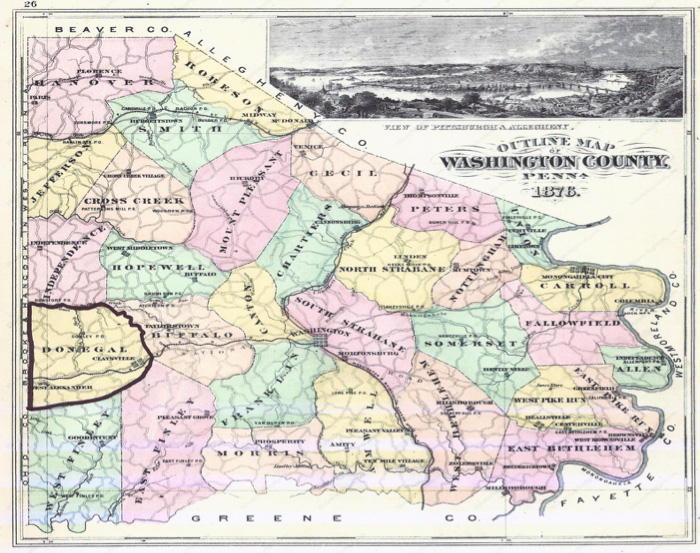
Washington County, Pennsylvania map of 1875.
George lived in Donegal Township in 1800 which was next to Brooke County, West Virginia.
1806
Ohio County, West Virginia, Court Order books show George McCrery [sic] was sued by Anne McDonnough.19
1810
No Ohio census is available.
A book about Licking County shows: "Burlington Township- The first settlers were ... in the year 1806… George McCrary [sic], ... came about 1810. The township was organized in 1817." It lies on the northern border adjoining Knox County.20
1820
Licking County, Burlington Township, Ohio, he is listed in the census as George McReary [sic] with 1 white male under age 10, 1 white male age 10-15, 1 white male age 45+ (George), 2 white females age 16-25 (perhaps Rebecca, Elizabeth or Mary his daughter), and 1 white female age 26-45 (unknown).
1826
Licking County, Ohio Tax record shows George McCrary [sic] listed in Burlington Township.21
1830
Licking County, Burlington Township, Ohio, he is listed as Geo McCrary [sic] with 1 white male, age 10-15, 1 white male age 60-70, and 1 white female, age 30-40. On the same census page is his son William McCreary and James McFarland his son-in-law.
1834
George McCreary applied for a pension based on his Revolutionary War service. I transcribed this with original spelling and punctuation.
In 1834 at age 82 he applied. He entered the service on May 1, 1776 from York Co. in Pennsylvania and was discharged Jan 5, 1777, McCreary, George, State Pennsylvania
The State of Ohio, Knox County
On the 24th day of January AD 1834 personally appeared before me one of the associate Judges of the Court of Common Pleas in and for the County and State aforesaid George McCreary a resident of the County of Knox in the State of Ohio aged eighty two years according to the best of his recollection who being first duly sworn according to law doth in his oath make the following declaration in order to obtain the benefit of the provision of the act of Congress passed June 7th 1832.
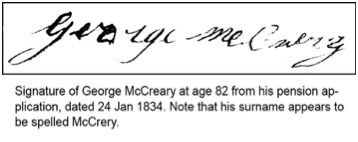
George McCreary's signature
That he entered the service of the United States under the following named officers and served as herein stated.
He entered the service as a volunteer about the first of May AD 1776 as near as he can recollect - The name of his Capt. was Gilleland and his first Sergeant was Montgomery and this applicant was Second Sergeant himself. He is unable to recollect the names of any of the rest of his Company or field officers except that he thinks his Colonels name was Reed. He thinks he received his discharge and left the service on the 5th of January AD 1777. When he entered the service he resided in the County of York in the State of Pennsylvania.
Immediately after volunteering he marched to the State of New Jersey and in a few weeks he joined what was called the flying Camp. He joined the flying Camp in Elizabeth Town in the State of New Jersey. He cannot recollect the name of his Captain in the Flying Camp. After joining the Camp he was engaged in one or two Skirmishes with the British and there he was marched to Fort Washington under the command of Colonel Magaro? [sic, probably Robert Magaw] and was a soldier in the Fort when Col. Magaro surrendered. He was at the surrender of the fort taken prisoner and marched to New York where he was put on board a British Man of War where he suffered the severest hardship both from cold and hunger. He was confined on board said ship eight or nine weeks during which time many of the soldiers who were confined with him died. He was then by? on the 5th of January 1777 as aforesaid discharged by the British on parole but was never called on and never returned. He never recd a written discharge of any kind. He has never been engaged in service since he was discharged as aforesaid. This applicant states that of late years his memory has very much failed, he is unable to recollect the names of many of his officers. He knew General Washington and saw him several times but never served under his immediate command. He has frequently seen General Lee and well remembers that he bore the character of being a strict and aged officer. He has no documentary evidence and knows of no person in the Country whose testimony he can procure who can testify to his service.
Interrogatories presented by the Judge
- Where and in what year were you born?
I was born in the County Armagh in Ireland and cannot tell the year but think it was AD 1752. - Have you any record of your age?
I have not and do not know of any in this Country to be found. - Where were you living when called into Service and where have you lived since the Revolutionary War and where do you now live?
Since he left the Service applicant states that he lived in York County, Pa., about eleven years, then moved to Washington County where he resided about nine years, then moved to Ohio County, Va. where he resided about five (might say four) years, he then moved into Ohio and resided in Licking County until the fall of 1832 when he removed to Knox County in said State where he now resides in the Township of Chester. - How were you called into Service?
I was a volunteer. - State names of some of the Regular Officers who were with the Capt. when you served such Continental Militia Regiments as you can recollect, and the general circumstances of your service?
I can recollect no other officers except those whose names I have before mentioned of Genls Washington, Lee and Col. Magaw. I cannot recollect any of the Continental or Militia Regiments. The general circumstances of my service are detailed in the body of this declaration. - Did you ever receive a discharge?
I never recd a written discharge but was discharged by the British on parole as herein before stated. - State the names of some persons to whom you are known in your present neighborhood and who can testify to you character for bravery and their belief of your service as a Soldier of the Revolution.
Aus? James Irwin a minister of the Gospel and Evan Holt and Moses Powell Esq. residing in Chester Township, Knox County, Ohio. Also the Honbl William Stansberry late a member of Congress residing in Licking Co. Ohio. This applicant also states he hereby relinquishes every claim whatever to a pension or annuity except the present and declares that his name is not on the pension roll of any of the agencies of any state or territory.
George McCreary (signature)
Sworn to and Subscribed this day and years above written before me.
Abner Ayers
Associate Judge of the Court of Common Pleas for Knox Co., Ohio
Circumstances and others that might be named convince me beyond doubt that he was actually a soldier in the Revolution and that he served as stated in this declaration herein before signed and sworn to by him. He is generally reputed and believed to have been a soldier and served in the Revolution and in that opinion I fully concur.
Evan Holt (signature) Sworn to and subscribed
The day and year above written before me
Personally appeared before me the undersigned one of the associate Judges for Knox Co. Pleas George McCreary who being duly sworn deposeth and saeth that by reason of old age and the consequent loss of memory he cannot swear positively as to the precise length of his service but according to the best of his recollection he served not less than the periods mentioned before and in the following grade - For the year 1776 ending 5th Jan 1777 eight months and 5 days I served as a private volunteer including the time of my imprisonment and detention by the British & for such service I claim a pension.
Given under my hand Abner Ayres
Associate Judge
Mr. James Irwin a clergyman residing in Bloomfield Township Knox Co. Ohio and Moses Powel Esq. residing in the Chester Township same county hereby certify that we are well acquainted with George McCreary who had subscribed and sworn to the above declaration that we believe him to be Eighty two years of age that he is respected and believed in the neighborhood where he resided to have been a soldier of the Revolution and we fully concur in that opinion.
James Irwin
Moses Powell
Sworn to and subscribed the day and year aforesaid
Abner Ayres
And I the said Abner Ayres one of the associate Judges of the Court of Com Pleas in and for the County of Knox Ohio do hereby declare my opinion after the investigation of the matter and after putting the interrogatories prescribed by the War Department that the above named applicant was a soldier of the Revolution and served as he states. And that James Irwin as it fully appears to me who has signed the preceding certificate is a clergyman residing in Blooomfield township Knox Co. Ohio and that Moses Powel Esq. who has also signed the same is a Justice of the Peace residing in Chester township same county and is a credible person and that their statement is entitled to the fullest credit and I do further certify that said George McCreary said applicant cannot prove bodily infirmity attend the court for the purpose of haveing his pension papers made out.
Given under my hand the day and years above written.
Abner Ayers
Associate Judge of Knox Com Pleas
State of Ohio
Knox County
I Evan Holt a revolutionary soldier residing in Chester township Knox County Ohio make solemn affidavit that I have been well acquainted with Georg McCreary the within applicant for a pension for upwards of twenty years past and I know him to be a man of truth and veracity and believe him to be a person of eighty years of age. He is reputed and believed in the neighborhood where he resided to have been a soldier of the Revolution and I have frequently heard him tell twenty years ago while his memory was good of his having been in the Revolutionary war and of having been in Fort Washington when he was taken by the British and of having been marched to New York and confined on board a British Man of War and of the hardship he there encountered. He said he must have died had it not been for a British Officer (a Sergeant) who was acquainted with him in his youth and who had been his playmate when they were both children. When this Sergeant learned who he was he used him very kindly and divided his rations with him. He stated many other circumstances at different times and uniformly told the same story and related them in the same way. These circumstance and others that might be named convince me beyond doubt that he was actually a soldier in the Revolution and that he served as stated in this declaration herein before signed and sworn to by him. He is generally reputed and believed to have been a soldier and served in the Revolution and in that opinion I fully concur.
Evan Holt
Sworn to and subscribed the day and years above written before me.
Abner Ayres
Associate Judge of Knox Com Pleas22

Pension document showing dollars owed
1837
29 June, George McCreary paid $100 to David Ogelvie and his wife Katharine to buy town lot 22 part of lot 6 in Range 15, Township 7 and Section 1, for $100 in Chesterville, Knox County. This was recorded 26 July 1837.23
29 June, George McCreary, bought from Enos Miles and Elizabeth, Range 15, Township 7, Section 2, part of lot 8, town lot 22 in Chesterville. This was recorded 26 July 1837.24
4 July, George McCreary (no wife listed) sold for $125 to John McCreary, Range 15, Township 7, Section 2, lot 6, town lot 22, Chesterville, for $125. I think this John is John McCreary, MD (son of Benjamin) who married Emily Brown in 1939 although it could be John McCreary, (son of Thomas McCreary) who moved to Indiana about 1850.25
I believe these land deals are the immigrant George McCreary but they could be his grandson George Washington McCreary who was in Knox County in the 1840s although he would have only been about age 25.
1840
George was age 88 at this time and was probably living with one of his children. His daughter Rebecca who was married to James McFarland was living in Clinton Township, Knox County, Ohio and a male age 80-89 was living with them which likely was George McCreary.
1842
George McCreary died 26 February 1842 in Knox County which is now Morrow County, Ohio. A court record in the Court of Common Pleas shows the following. On motion to the court and upon this production of satisfactory proof, it is ordered that the Clerk list on the Journal that satisfactory proof has been addressed to this court that George McCreary deceased was a pensionary of the United States that he died on the 26th day of February 1842 leaving Mary McCreary his only child and sole heir at law, and that said Mary is a resident of the County of Knox, Ohio and is a person of good moral character and that he G. McCreary left no widow.26 This record is confusing since Mary was not his only living child at that time. Did George and Mary not know that other children were living because of communication difficulty and the fact that the siblings lived in other towns? Or did George want to give all his assets to Mary because she lived nearby and perhaps helped take care of him? Mary may have been one of the younger children and perhaps he wanted to leave her everything, or did Mary not tell the court of her other siblings?
George died intestate (without a will) in Knox County so no further details are available.27
George McCreary is buried in Chester Baptist Church Cemetery and the inscription says George McCreary b. 1752 Co. Armagh Province of Ulster Ireland d. Feb 26, 1842 Private Penn. Militia War of the American Revolution. Several other McCrearys are buried nearby including his son Benjamin and daughter-in-law Deborah, grandsons George and Ezra McCreary (sons of Benjamin), and Benjamin McCreary his great grandson.
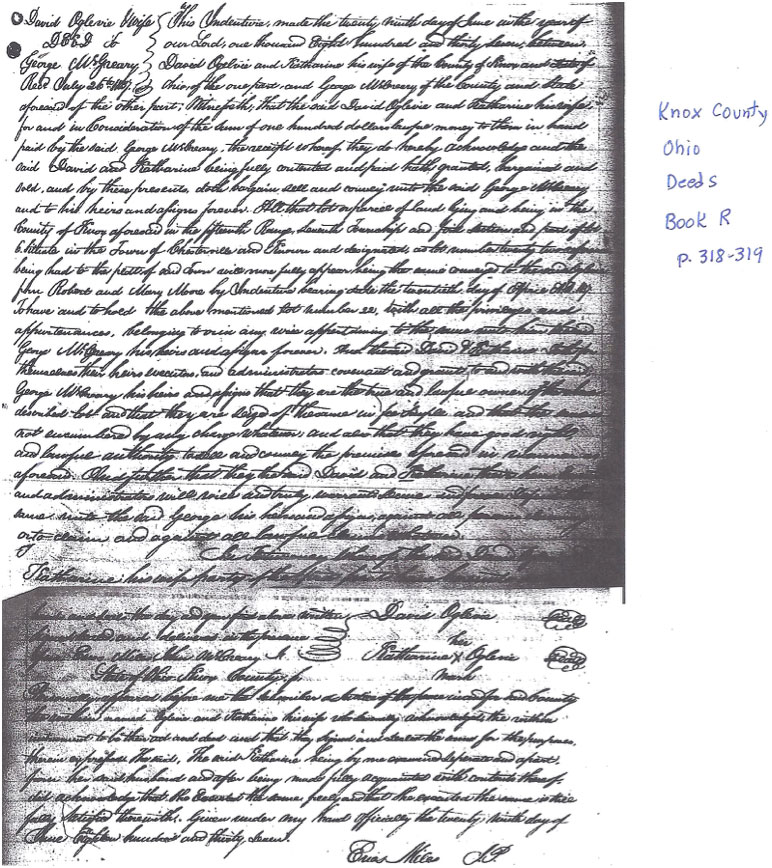
George McCreary lot 22 Knox County
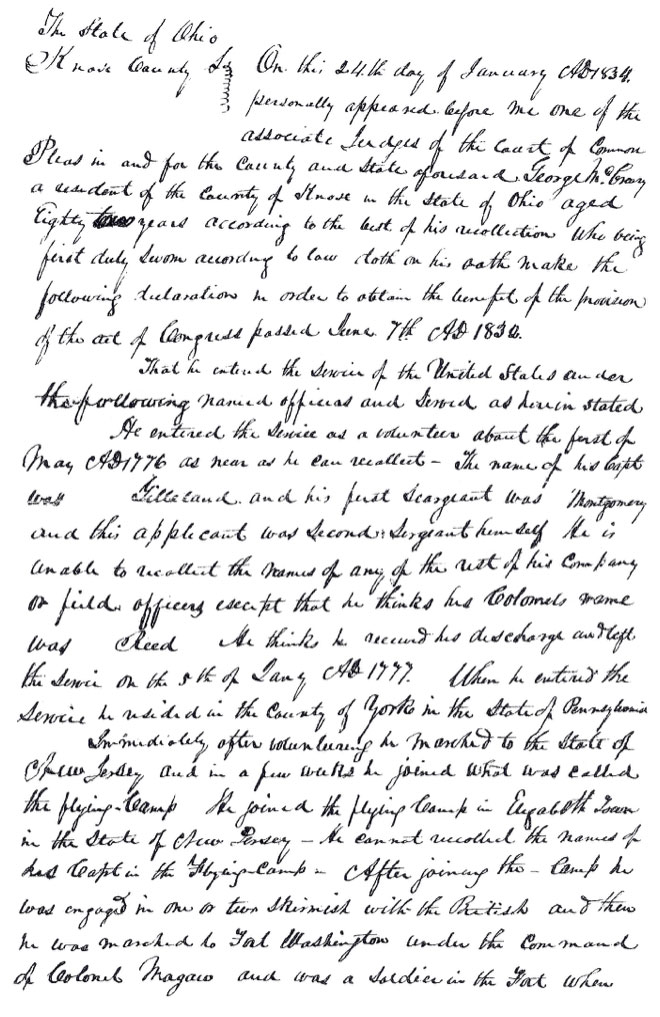
George McCreary testimony p. 1
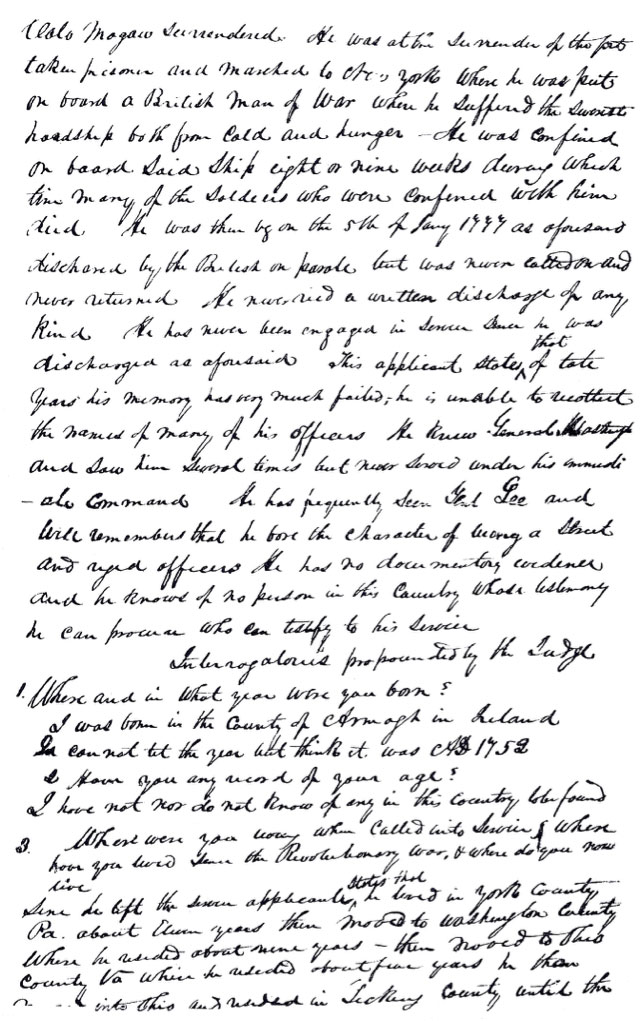
George McCreary testimony p. 2
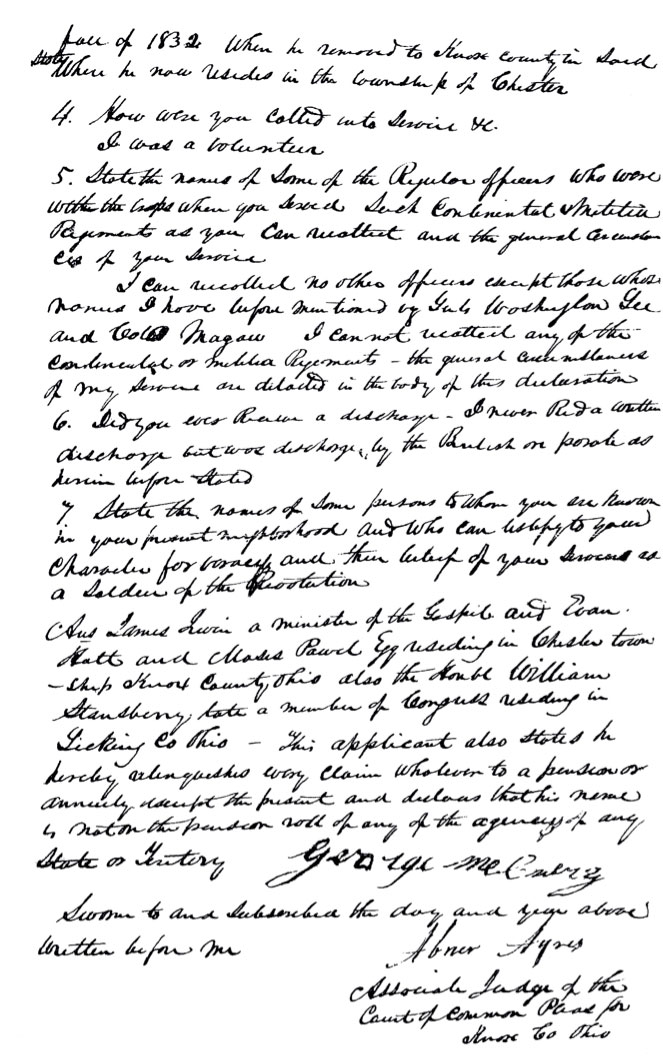
George McCreary testimony p. 3
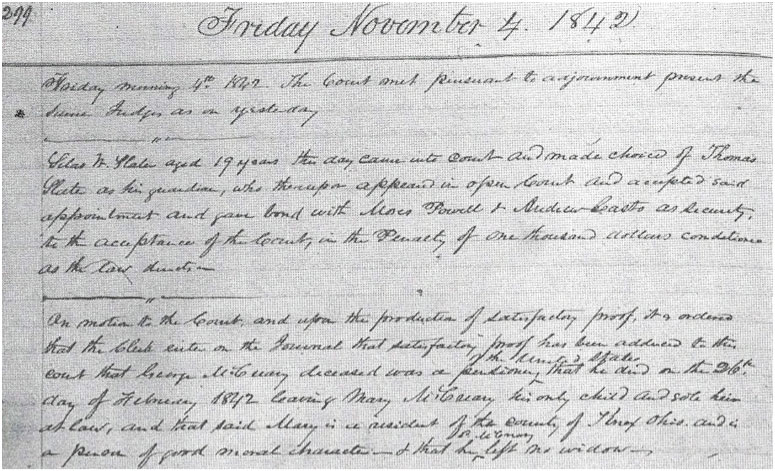
George McCreary, Court of Common Pleas, 1842, Book K, p. 299
Some History of the American Revolutionary War —
The Battle of Fort Washington which was mentioned by George McCreary, was fought in New York where Manhattan is today, overlooking the Hudson River between the American Continental Army and Great Britain on 16 November 1776. It was a British victory and Colonel Magaw surrendered. General George Washington ordered Colonel Magaw to abandon the fort but the Colonel decided to stay and fight the British. The British army under command of William Howe attacked the fort from the north, east and south. The British had hired Hessians from Germany to fight with the British and they had about 8000 troops and the Americans only about 3000. Ultimately Colonel Magaw surrendered the Fort. The Americans had over 2800 captured as prisoners of the British. The captives were marched to captured and damaged ships that were used as prisons. Prisoners died from the cold and lack of food. Supplies for the captives were expected to be provided by the American army or other means, not by the British. Prisoners could be paroled in exchange for their promise not to resume the war and according to George McCreary he apparently was paroled after being aided with food by a British friend. Over 10,000 other prisoners died from neglect.28
In a book, American Prisoners of the Revolution, the following stories were quoted from local newspapers of the time describing the conditions on the prisoner of war ships. From Freeman’s Journal, date of Jan. 19th, 1777; we take the following: “General Howe has discharged all the privates who were prisoners in New York. Half he sent to the world of spirits for want of food: the others he hath sent to warn their countrymen of the danger of falling into his hands, and to convince them occular demonstration, that it is infinitely better to be slain in battle, than to be taken prison by British brutes, whose tender mercies are cruelties.” In the Connecticut Journal of Jan. 30th, 1777, is the following: “This account of the sufferings of these unfortunate men was obtained from the prisoners themselves. As soon as they were taken they were robbed of all their baggage; of whatever money they had though it were of paper; of their silver shoe buckles and knee buckles, etc.; and many were stripped almost of their clothes. Especially those who had good clothes were stripped at once, being told that such were ‘too good for rebels.’ Thus deprived of their clothes and baggage, they were unable to shift even their linen, and were obliged to wear the same shirts for even three or four months together, whereby they became extremely nasty; and this of itself was sufficient to bring on them many mortal diseases. After they were taken they were in the first place put on board the ships, and thrust down into the hold, where not a breath of fresh air could be obtained, and they were nearly suffocated for want of air. Some who were taken at Fort Washington were first in this manner thrust down into the hold of vessels in such numbers that even in the cold season of November they could scarcely bear any clothes on them, being kept in a constant sweat…”29
Correspondence in his pension file shows the pension office replied to inquiries from descendants with the following information. While living in York County, Pennsylvania he volunteered May 1, 1776 as a private in Captain Gilliland’s Company, under Colonel Reed, Pennsylvania Troops; he joined the Flying Camp at Elizabeth, New Jersey, and was then stationed at Fort Washington under Colonel Magaw. He was captured when Fort Washington surrendered, confined on a British ship in New York Harbor, and was released on parole January 5, 1777.30
Correspondence in 1834 when George was trying to obtain his pension states “The claim of George McCreary has been again examined and the papers are herewith returned. The only objection to the admission of this claim is that Evan Holt the witness is not certified to be credible.” George’s lawyer wrote back on the same document, “Sir again returning the papers containing George McCreary application for a pension after procuring the certificate as to the credibility of Evan Holt.”
Jill Carter Knuth, a descendant of the McCreary and James families, visited in September 2013, counties in Ohio associated with the McCreary family. She wrote the following based on her observations of her trip and research.
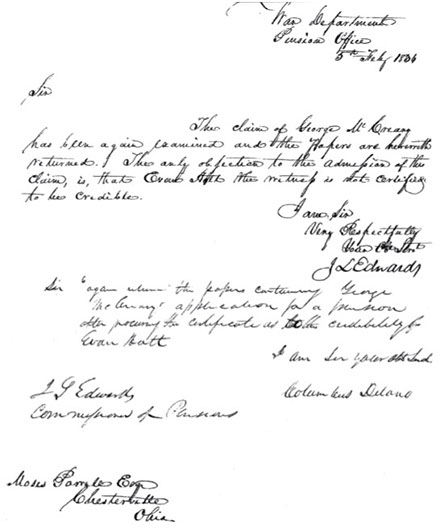
George McCreary pension correspondence
THE UNITED STATES MILITARY DISTRICT
George McCreary and family migrated about 1810 from Ohio County, Virginia, [now West Virginia] to Licking County, Ohio. George was nearly 60 years old at the time. Soon after he arrived in Licking County, some of his adult children moved on to Knox [now Morrow] County, Ohio.
These counties in Ohio were part of the U.S. Military District, Federal lands reserved for veterans of the Revolutionary War. In 1797 the land was surveyed into ranges (five mile wide strips running north and south from a base line) and townships (five mile wide strips running east and west from a base line.) Each township was divided into quarters of 4000 acres each. In 1800, the unclaimed quarters were divided into 100 acre lots (not to be confused with town lots). In 1803, unclaimed land was divided into sections, each one square mile, and sold under the general terms for other Federal lands.
From the census records of 1820 and 1830 we learn that George McCreary resided in Burlington Township, Licking County, (also described as range 13, township 4). Since his service in the Revolutionary War has been well documented, we might assume he had claimed bounty land in the U.S. Military District. But this does not seem to have been the case.
Burlington Township (Range 13, Township 4) was divided into quarters of about 4000 acres each, and the four original owners, called entrymen, were:
Quarter 1, NE: Galbreath V. Elmes
Quarter 2, NW: Jonas Stanbury and Lucy, his wife, from New York. Stanbury divided his land into small parcels and sold them one-by-one.
Quarter 3, SW: Abraham Baldwin, from Columbia, Georgia. Baldwin died in 1807 and his land in Quarter 3 was divided amoung his heirs, none of whom seem to be connected with the McCrearys.
Quarter 4, SE: William Steele
Many of the entrymen never saw the land they claimed or bought. They were speculators who often operated in collaboration with lawyers and agents who bought bounty warrants from Revolutionary War veterans and consolidated parcels.
If George McCreary did not claim bounty land, and indeed, did not own any land in Licking County that we have been able to discover, why did he choose to live there? Did he follow an already-married child?
We don't know where or when George's oldest son, Thomas, was married, but it may have been about 1801. And we don't know his whereabouts until 1819 when he shows up in the records of Chester Baptist Church in Knox [now Morrow] County, Ohio.
James married in 1810 in Knox [now Morrow] County, Ohio. Benjamin married in 1812 in Licking County, and was in Knox [now Morrow] County by 1824. George's son, William, is a mystery.
George's daughter, Nancy, married in 1811, Licking County, to a David Evans. There is more than one man by this name in the early records of Licking County. One property deed recorded in 1828 names David Evans and Nancy, his wife, as the grantors of land in Fallsbury Township. But there is also a record for David Evans, III, who married in 1804, Virginia, to Nancy Smith. So it is difficult to tell which David Evans, was Nancy McCreary's husband.
Rebecca married in 1822, Licking County, to James McFarland. This family seems to have stayed in Licking County.
Elizabeth married in 1825, Licking County, to Alexander McFarland, reputedly a brother of James McFarland. There are subsequent records for an Alexander McFarland in both Licking and Knox Counties.
One researcher found records of a Mary McCreary married to James Dunlap. This was probably the surveyor, James Dunlap, who made the original survey of Burlington Township, and bought a parcel of land there where he and his family resided until the 1840s. But the Martin McCreary Family Tree (and others) on ancestry.com say that this Mary McCreary was born in 1775 in Maryland, and was the daughter of Thomas and Margaret McCreary.
Eva Gardner, a granddaughter of George Washington McCreary, said that George the immigrant did have a daughter, Mary, who died unmarried. She was "unfortunate" and had a "simple" son who died in early adulthood. Most of the information from Eva Gardner has proven to be accurate, and this relationship is verified in a curious court notation made in Knox County at the time George died in 1842. According to a county clerk to whom I showed the record in 2013, this was not part of a probate procedure — George seems to have died intestate, (without a will), so he may not have left an estate. The court note was verification that Mary was single and the only heir of her father. We know that several others of George's children were living at this time, so this may have been a legal fiction to allow George's military pension to continue to support a dependent female, relieving her siblings of the responsibility.
So if George McCreary did not move to Licking County to be near an already-married child, what other reasons might he have had?
George's wife was Mary McQuown. A James McQuown bought land in the south part of Union Township in 1821. Minor McQuen bought land in Fallsbury Township in 1832, and later, there were several land transactions in Licking County involving people by the name of McCune. Mary McQuown had several brothers who are named in the will of their father, Lawrence McQuown, in York County, Pennsylvania, but we don't know their subsequent history, and no one with a similar name seems to have acquired land in Licking County early enough to have attracted George McCreary there.
It may be helpful to understand how and by what route the McCreary family made their way to northern Licking County.
We know the McCrearys had previously lived in Donegal Township, Washington County, Pennsylvania. From there, they moved a mere 20 miles west to the area of Wheeling, Ohio County, West Virginia, where they stayed for a few years. About 1810, the McCreary family packed their belongings again, and probably traveled for about 75 miles from Wheeling to Zanesville, Ohio, along Zane's Trace; the road passed just south of the south-east corner of Licking County. After Ohio had become a state in 1803, this rough trail had been improved to accommodate wagons. The last 35 miles of the journey from Zanesville to northern Licking County would have been rougher; the settlers may have followed Indian trails.
But some route from Zanesville into Licking County had evidently been opened in the first decade of the 19th century. "A Centennial History of Licking County, Ohio", (by Isaac Smucker, July 1886; printed by Clark and Underwood, Newark, Ohio) noted that many of the early settlers of Licking County came from Brooke County, Virginia [now West Virginia], the small county just north of Wheeling. We can draw a reasonable inference that the McCreary family was part of that migration, but the exact reason for their journey remains unknown.
No original documents have been located that name all of George’s children and their birthdates so the following is based on reports from other researchers and some proof as noted in later chapters. I’ve searched for a will, probate records, deeds, church records, and other documents which might have named his children but no record has been found. His children were named by John Householder (grandson of George Washington McCreary and great-great grandson of George McCreary the immigrant) at the 1901 McCreary reunion in Bradner, Ohio but there’s no documentation of the source. See the appendix for the speeches given at the reunion. Also they were named by Eva Gardner who was born in 1869 and was George’s great-great granddaughter, in a letter she wrote in 1937. However there could be errors in the following birth dates and birth order.
Children of George1 and Mary (McQuown) McCreary:
- THOMAS2 MCCREARY, born 22 July about 1781 in Menallen Township, York County, Pennsylvania. He died 3 October 1855 in Morrow County, Ohio. He married Elizabeth Roberts about 1801. See Chapter II.
- NANCY 2 MCCREARY, born about 1785 in York County, Pennsylvania and married David Evans, 4 August 1811, Licking County, Ohio. See Chapter III.
- JAMES2 MCCREARY SR., born about 1789 probably in York County, Pennsylvania and apparently died 12 February 1871 in Guilford Township, Monroe County, Iowa. He married (1) Mary Holt, 10 June 1810, Knox County, Ohio , (2) Rachel Westbrook Cole, 9 July 1831, Knox County, Ohio; and (3) Margaret Clapp, 16 November 1841, Kendall County, Illinois. See Chapter IV.
- BENJAMIN2 MCCREARY, born about 30 August 1791 in York County, Pennsylvania and died about 12 July 1866 in Morrow County, Ohio. He married Deborah Mathews, 31 December 1812 in Licking County. See Chapter V.
- REBECCA2 MCCREARY, born about 1796probably in York County, Pennsylvania and died 30 August 1869. Rebecca McCrary [sic] married James McFarlin [sic probably should be McFarland], 26 February 1822, Licking County, Ohio. See Chapter VI.
- ELIZABETH MCCREARY, born 6 February 1799 in Washington County, Pennsylvania and she married Alexander McFarland, 5 April 1825, Licking County, Ohio. See Chapter VII.
- WILLIAM MCCREARY, probably born 1802 in Washington County, Pennsylvania. He married Matilda Grant, 29 April 1830, Knox County, Ohio. See Chapter VIII.
- SARAH MCCREARY. May have been born Ohio County, Virginia or Licking County, Ohio but the year is unknown. See Chapter IX.
- MARY MCCREARY. Some researchers say she was born about 12 November 1796 and some show her as the fourth child, but no proof has been found. See Chapter X.
— NOTES —
The following abbreviations are used in these notes.
National Archives Records Administration — NARA
1 NARA, Pension file of George McCreary, file S8883, is 41 legal pages; and Heritage Quest, Revolutionary War Image has 8 pages, Series M805, roll 566, image 424.
2 Findagrave.com.
3 Correspondence dated 25 May 1937 from Eva Gardner to W. O. McCreary Sr., now in the possession of Wendy Wilson.
4 Marjorie MacCreary, The John McCreary Clan, John McCreary 1710-1777, a typed report by her in 1961 found at the Allen County Library.
5 List of Inhabitants of Town of Armagh for use of his Grace the Lord Primate, 1770, FHL film 279,327, item 14.
6 Armagh Presbyterian Registers, FHL film 1,279,329, item 22.
7 Sir Charles Coote, Statistical Survey of the County of Armagh (Dublin, 1804), reprinted 1984.
8 Ian Maxwell, Researching Armagh Ancestors (Ulster Historical Foundation, 2000) pages 124-125.
9 Genealogy Society of Ireland Journal, Dun Laoghaire County, Dublin, Ireland, Spring 2001, Vol.2 Iss 1, pages 62-64, written by Thomas E. McQuown.
10 H, N, Hervey, Historical Sketches of Presbyterian Churches in Licking County, Ohio (Newark, Ohio: Wilson & Clark, printers) page 17-19
11 Wrote to NARA in June 2003 and ordered his Military Service Records but they were unable to locate it.
12 Tax List of York County 1779, (Westminster, Maryland, Family Line Publications, 1989) pages 52-53.
13 Mary Marshall Brewer, Land Records of York County Pennsylvania 1775-1793 (Lewes, Delaware: Colonial Roots), 2004, p. 256.
14 Henry James Young, York County, Pennsylvania in the American Revolution A source Book (1935), Volume I, copy courtesy York County Heritage Trust.
15 York County, PA Wills 1749-1819, Ancestry.com.
16 Wilbur J. McElwain, United States Direct Tax of 1798 Tax Lists for Washington County, Pennsylvania (Bowie, Maryland: Heritage Books, 1997) page70.
17 Kenneth F. Craft Sr., Ohio County, West Virginia Index to County Court Order Books, Vol 3, page703 (Wellsburg, West Virginia: Heritage Books Inc., 2000), order book 8: 293.
18 Kenneth F. Craft Sr., Ohio County, West Virginia Index to County Court Order Books, Vol 8, page1903 (Wellsburg, West Virginia: Heritage Books Inc., 2000), card #752, contents of file have petition & summons, note, envelope 13A in County Court.
19 Kenneth F. Craft Sr., Ohio County, West Virginia Index to County Court Order Books, Vol 4, page1133 (Wellsburg, West Virginia: Heritage Books Inc., 2000), order book 10: 340.
20 L. H. Everts, 1875 History of Licking County, Ohio, (Knightstown, Indiana, 1975); and N. N. Hill Jr., History of Licking Co. Its Past & Present, (Newark, Ohio: A. A. Grahan & Co., 1881), p 407.
21 Diane Pheneger, Index 1826 Licking County, Ohio Tax Records (Newark, Ohio: Licking county Genealogical Society, 1988), page131.
22 NARA, Pension file of George McCreary, file S8883, is 41 legal pages; and Heritage Quest, Revolutionary War Image has 8 pages of it, Series M805, roll 566, image 424,
23 Knox County, Ohio, Deed Book R: 318.
24 Knox County, Ohio, Deed Book R: 319.
25 Knox County, Ohio, Deed Book R: 320.
26 Knox County, Ohio, Court of Common Pleas Minutes, Book K: 299, FHL film 1,294,313, November 4, 1842.
27 Carol W. Bell, Ohio Wills and Estates to 1850: An Index, (Columbus, Ohio: C. W. Bell, 1981).
28 From various sites including Wikipedia and other internet sites.
29 Danske Dandridge, American Prisoners of the Revolution (Clearfield Publishing, no date), page193.
30 Correspondence in 1928 from Winifred Scott, Commissioner, Bureau of Pensions to Mrs. E. H. Dennis Rock Valley, Iowa.
31 Polly Barcus & Mildred Francis, Licking Co., Ohio Marriages 1808-1875 (Newark, Ohio: Licking County Genealogical Society, 1984), page14, McCreary, Nancy & Evans, David.
32 Morrow County Records, Book A:17, Married on the 10th day of June AD 1810 James McCreary to Mary Holt, Daniel Ayres JP, courtesy of John Hall.
33 Knox County, Ohio Records, Book B:143, 9th day of July last by virtue of a license from this Court CC pleas of K. county, Jas McCreary & Rachel Cole were legally joined in marriage by me a Justice of the peace in and for said County. Given under my hand this 2nd day of August 1831. M Anderson J.P.
34 Kendall County, Illinois, Register of Marriages 1841-1915, FHL film 1,403,534, page 1, Nov 16, 1841, license #12 James McCrarey [sic] and Margaret Clapp, married on Nov 19, 1841 by Almon Ivia, Justice of the Peace, recorded Nov 24, 1841.
35 Polly Barcus & Mildred Francis, Licking Co., Ohio Marriages 1808-1875 (Newark, Ohio: Licking County Genealogical Society, 1984), page21, McKrevy [sic], Benjamin & Mathew, Deborah.
36 Jean, Nathan, Ohio Marriages recorded in County Courts 1 January 1821-31 December 1830 an index, (Mansfield, Ohio: The Ohio Genealogical Society 2003) McCrary, Rebecca and McFarlin, James 26 Feb 1822a Licking County Vol 1:135.
37 Polly Barcus & Mildred Francis, Licking Co., Ohio Marriages 1808-1875 (Newark, Ohio: Licking County Genealogical Society, 1984), Vol 1: 198.
© Marian McCreary 2015